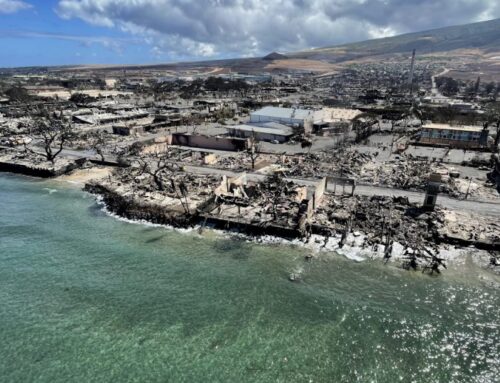The Maui wildfires are estimated to cost insurers up to US$3-billion in damages, creating one of the largest insured losses in Hawaii’s history, according to an analyst report. This leads many property owners wondering if the tragedy will result in higher homeowners insurance rates across Hawai‘i. And as natural disasters are escalated by climate change, will policies be adequate or even obtainable? We’ve gathered some experts opinions.
The Aug. 8 blazes did the most destruction in Lahaina, but residents in Upcountry also suffered heavy damage. Data from the U.S. Federal Emergency Management Agency indicates that 86 per cent of the approximately 2200 buildings damaged in the Maui fires were residential. As a result, analysts predict those insurers who sell the homeowners’ multiperil policies will see the largest impact.
Here is a quote from Reid Hokama, vice president of Personal Lines and Marketing at Island Insurance, and quoted in Honolulu Magazine.
“Climate change is impacting weather patterns across the globe, leading to an increase in severity and frequency of natural disasters, as well as unusual weather events. We have seen the insurance industry adjusting property underwriting practices to account for these new realities. Some large mainland insurers have recently taken drastic steps like pulling out of writing homeowners insurance in select states on the mainland. Hawai‘i property insurance premiums have been rising over the past few years, and we are not immune to the impacts of climate change. Even with this as a backdrop, it’s too soon to say for sure how rates will be impacted.”
Will insurers pull out of the Hawaii market?
Jing Ai, a finance, risk management and insurance professor at the University of Hawaii had this to say in a Civil Beat report: “Wildfires have become more of a concern for every insurance company in a lot of parts of the country, including (Hawaii),” said Jing Ai, “And this particular tragic and large-scale event just makes it more urgent for them to reevaluate.”
However, Ito said he wasn’t aware of any insurers planning to pull out of the state because of the fires. Companies could be re-assessing their risk in Hawaii, but it likely won’t be as bad as California and Florida.
“Fortunately, Hawaii’s market has been stable for many, many years,” Ito said. “For the most part, whether it’s homeowners, hurricane or motor vehicle, there is still availability, unlike other states.”
However, at least one company has issued a moratorium on new fire policies in parts of Maui where the wildfires are still actively burning. According to a representative from State Farm Insurance, moritoriums are typical when fires are still burning or have recently experienced a fire. Moritoriums are typically removed when the threat has passed.
Is an insurance safety net an option?
There are concerns that the Hawaii Property Insurance Association (HPIA), which serves as a safety net for property insurance in the state, may not be ready to handle an increasing number of Hawaii homeowners who might struggle to secure insurance in the near future. This could happen as insurance companies reevaluate the risks they are willing to cover.
HPIA was established as a nonprofit organization back in 1991 with the aim of offering basic property insurance to residents who have been turned down for coverage by private insurance companies at least two times. However, the strong demand for insurance could overwhelm the resources and capabilities of this association.
Compared to private insurance companies, HPIA typically charges higher premiums for providing less coverage. Additionally, the maximum coverage limit offered by the association is $450,000, which is considerably less than the average price of a single-family home in Hawaii. Compare this to a similar safety net program in California, the FAIR Plan, which provides coverage up to $3M.
In December 2022, the Insurance Division approved an increase in insurance rates, prompting HPIA to raise its monthly premiums for coverage this year. However, expanding the program, to cover more homeowners and at a higher amount, would take some time.
How can homeowners statewide prepare themselves in case of a fire?
Hokama recommends reviewing your homeowners insurance policy with your insurance agent to make sure you understand your current coverages and whether they adequately protect you in the event of a loss.
Note that homeowner’s insurance typically covers all listed structures and most contents. However, high-value contents, like jewelry, may require additional coverage. Also, flood insurance is a separate policy.
Update your contact information regularly. Save digital copies of important documents like your insurance policies and mortgage statement. Take photos or videos of belongings, including furniture, appliances, jewelry and other items. Document both the exterior and interior of your home and car.
Upload the important documents and the inventories to a data cloud or email it to yourself. That will help make sure your information is saved and safeguarded, even if your hard copies and smartphone are destroyed. Having this information can simplify the process of filing an insurance claim if your home is damaged. If your home is impacted by a fire, your insurer may ask questions regarding the layout of your home. They may also ask for photos of your home and property.
Also, make sure to have a family emergency plan for various types of natural disasters, including fire. And minimize or clear your home and property of combustible materials, improperly stored flammable liquids, or overgrowth of dry vegetation.
The answer?
It seems we don’t know yet how the Maui wildfires will affect insurance rates, but the Hawaii market is more stable than other coastal regions.






